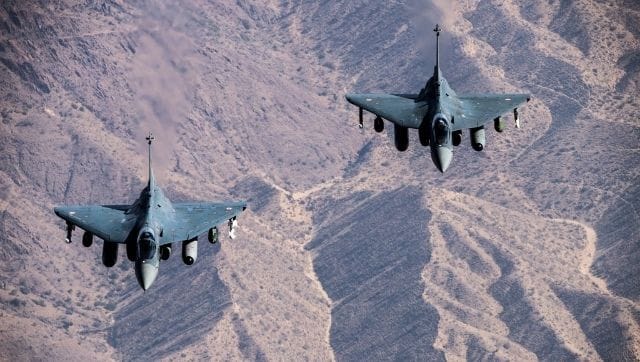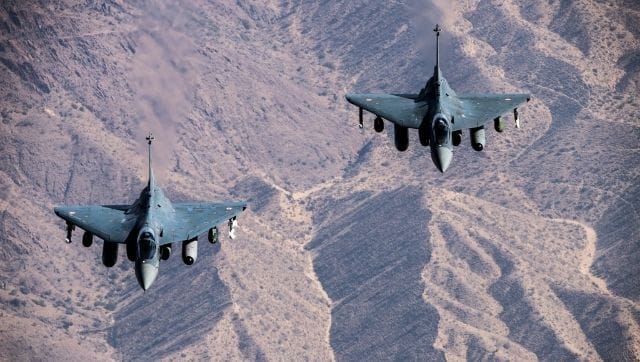The current geopolitical situation in which the Indian forces remain in a tense face-off with China along the northern border has necessitated the emergency purchases

Two Tejas HAL light combat aircrafts take flight. Image via Wikimedia Commons
Union Budget 2021 increased the overall allocation for the defence sector by Rs 7,000 crore over the last year to Rs 4.78 lakh crore, which after pensions amounts to Rs 3.62 lakh crore. This includes an increase in the capital outlay to Rs 1.35 lakh crore as compared to the previous year’s allocation of Rs 1.18 lakh crore (14 percent increase), and this amount will largely go towards fulfilling the emergency purchases done last year during the face-off with China.
The emergency purchases are expected to be completed by the end of FY 2021, and hence the increased allocation. Revenue allocation has also increased from Rs 2.18 lakh crore to Rs 2.27 lakh crore. It is worth noting that the pension bill is estimated to be Rs 1.16 lakh crore, down from Rs 1.33 lakh crore. The significant reduction has helped increase the capital and revenue allocation while only marginally increasing the overall expenditure.
The current geopolitical situation in which the Indian forces remain in a tense face-off with China along the northern border has necessitated the emergency purchases, which are being reflected in the current year’s allocation. Any worsening of the situation could probably lead to further allocations as per the situation. It may also be noted that the Chiefs of the three services had been given financial powers of Rs 500 crore to process operational necessity equipment without going through the acquisition cycle.
The allocated capital outlay is sufficient to meet the foreseen contractual obligations in 2021. Any upcoming contract for new equipment will only require Budget allocation in subsequent years due to the long delivery cycle associated with defense items. The two major contracts which are likely to be signed off this year are the HAL Tejas MK 1 A (Rs 38,000 crores) which reportedly is likely to be financed by the stake sale of Hindustan Aeronautics Ltd (HAL). The other major deals on the cards such as the naval acquisition of carrier-borne fighters and joint manufacturing of C-295 would require only an initial down payment.
Depending on how the situation with China plays out, the current year is expected to witness a higher spend on weapons, and other items like ISR (Intelligence, Surveillance, and Reconnaissance) Assets (Unmanned Aerial Vehicles (UAVs)), and battlefield situational awareness systems. These could be procured under the special power provided to the Chiefs of the Armed Forces for rapid acquisition.
Further, strategic equipment could also be sourced under the newly introduced Leasing category in Defence Acquisition Procedure 2020, which would require a lesser upfront capital expenditure. India has already leased MQ 9 UAVs under this category and is reportedly looking at procuring the Light Utility Helicopters. On the other hand, the Indian Air Force is reportedly looking to lease refuellers under the provision.
The fine print needs to be seen for evaluation of the impact of the earlier announced Atma Nirbhar reforms. For instance, the Atma Nirbhar reforms had promised a separate allocation for domestic sourcing to promote the indigenous industry. However, the same has not been commented on.
While there has been an increase in capital allocation, the absence of any reference to the defence budget by the finance minister (erstwhile the defence minister) in her speech was a bit surprising. The defence industry has a long cycle, and a plan for the current year allocation as well as the long-term plan for capability building/ making up the current inventory shortfall would have been extremely welcome in light of the elevated geopolitical situation.
Top 3 expected growth drivers for 2021-22
- Leasing option is likely to become popular in light of acquiring much-required assets as the capital acquisition procedure is time-consuming. The leasing option not only reduces the upfront capital expenditure but also the time taken to ensure it is operational. Light Utility Helicopter and refuellers could be next in line after the MQ 9 UAVs
- Equipment associated with enhanced battlefield operations and situational awareness, for instance, UAVs, communication equipment, weapons, sensors, etc
- Fine print will determine the boost to indigenous industry; especially the allocation of a separate domestic defence budget.
The writer is Director, Aerospace, Defence and Security Practice, Frost and Sullivan
Find latest and upcoming tech gadgets online on Tech2 Gadgets. Get technology news, gadgets reviews & ratings. Popular gadgets including laptop, tablet and mobile specifications, features, prices, comparison.
This article is auto-generated by Algorithm Source: www.firstpost.com


